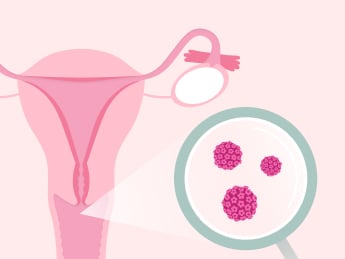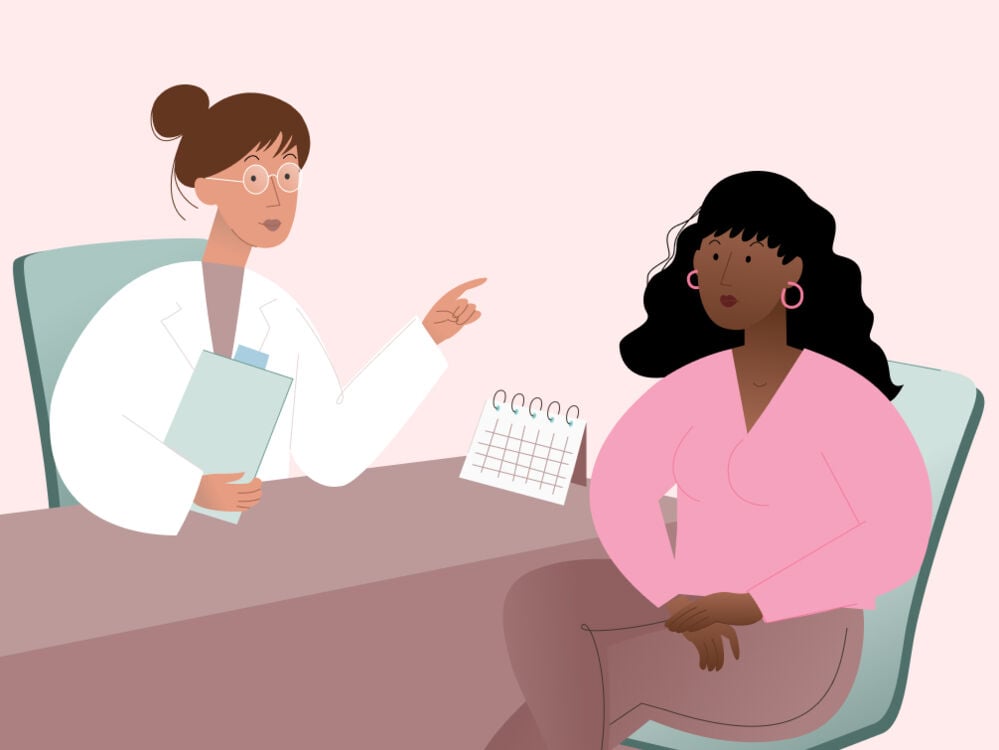Receiving an abnormal Pap smear result can be scary, but it’s also very common and often nothing to worry about. Here, an OB-GYN explains how common abnormal Pap smears are, what causes them, and what happens next.
-
Tracking cycle
-
Getting pregnant
-
Pregnancy
-
Help Center
-
Flo for Partners
-
Anonymous Mode
-
Flo app reviews
-
Flo Premium New
-
Secret Chats New
-
Symptom Checker New
-
Your cycle
-
Health 360°
-
Getting pregnant
-
Pregnancy
-
Being a mom
-
LGBTQ+
-
Quizzes
-
Ovulation calculator
-
hCG calculator
-
Pregnancy test calculator
-
Menstrual cycle calculator
-
Period calculator
-
Implantation calculator
-
Pregnancy weeks to months calculator
-
Pregnancy due date calculator
-
IVF and FET due date calculator
-
Due date calculator by ultrasound
-
Medical Affairs
-
Science & Research
-
Pass It On Project New
-
Privacy Portal
-
Press Center
-
Flo Accuracy
-
Careers
-
Contact Us
Abnormal Pap smear: What happens next?


Every piece of content at Flo Health adheres to the highest editorial standards for language, style, and medical accuracy. To learn what we do to deliver the best health and lifestyle insights to you, check out our content review principles.
If you’ve received an abnormal Pap smear result, then it’s normal to feel worried. You’ll probably have lots of questions about what happens next. We’re here to help answer them with help from an expert.
Rest assured, abnormal Pap smear results are more common than you might think. In fact, the British Society for Colposcopy and Cervical Pathology says one in 20 women will receive an abnormal smear test result in their lifetime, but only one in 2,000 will have cervical cancer.
Keep in mind that Pap smears are done to prevent cervical cancer. Having an abnormal Pap smear does not mean that you have cervical cancer. The most important thing is to attend your follow-up appointment where your health care provider will be able to take a closer look at what’s going on, refer you for further tests, and provide any advice or support you need.
Here, Dr. Charlsie Celestine, Flo board member, and obstetrician, and gynecologist, explains why your test may come back abnormal and any follow-up tests your health care provider may recommend.
What happens at a Pap smear?
If you’re over 21 in the United States or 25 or above in the United Kingdom, then you may have already been invited for your first Pap smear. Understanding exactly what to expect can help soothe some of the fears or uncertainty you might have.
The procedure — also known as a Pap test or cervical screening — is usually quick, simple, and aside from the slight discomfort some of us experience when the speculum (a smooth, tube-shaped tool to open up the vagina) goes in, pretty much pain-free.
Over to Dr. Celestine to explain more. “You’ll come into the office, lie down on the table, and we put your feet in what we call the stirrups,” she says. “These keep your legs open and separated so that we can use a speculum to see the cervix.”
Your cervix is the small, round portion of your uterus that makes up the passage between your uterus and your vagina. “Once we see the cervix, we use a couple of tools to brush some of the cells off, and then we send those cells to the lab,” says Dr. Celestine.
Take a quiz
Find out what you can do with our Health Assistant
These cells will then be checked under a microscope for changes caused by human papillomavirus (HPV) — the collective term for a group of viruses that affect the skin and can cause cervical cancer or precancer (dysplasia). For most people, HPV clears up on its own and causes no further health problems, but in some cases, it can lead to cervical cancer if it is not detected and treated. More on that below.
If you experience any pain during your Pap smear, then don’t be afraid to speak up. Your medical professional may be able to use a different speculum or change your positioning to make things less uncomfortable.
While your Pap smear appointment can be over in 10 minutes, you may feel nervous while waiting for your results. That’s totally normal. Your health care provider will usually contact you within one to three weeks. Your results will be listed as normal or negative (meaning no changes in your cells), unclear, or abnormal. But what does it mean if you get an abnormal Pap smear, and what happens next?
What is an abnormal Pap smear?
Hearing that your Pap smear test has come back abnormal can be frightening. However, it doesn’t mean that you have cancer. It just means that your health care provider has found abnormal cells on your cervix — and it’s important to check if they could be precancerous.
Healthy cervical cells are thin and flat. If your Pap test is abnormal, your sample contained abnormally shaped cervical cells.
Before you panic, remember that these cells can also be a sign of other things like yeast infections, inflammation, low hormone levels, noncancerous cysts, and fibroids (noncancerous growths), which are all easily treatable. Your health care professional will be able to talk you through what might be going on and refer you for more tests if needed.
Are abnormal Pap smears common?
Yes, both abnormal Pap smear results and contact with HPV are “very common,” according to Dr. Celestine. In fact “about 70% to 80% of [sexually active] people have come in contact with [HPV] in their life.”
In the United Kingdom, about 1 in 20 people with a cervix will have a smear test result that is abnormal, and one study estimates that the probability of someone getting HPV in their lifetime is 84.6% for women and 91.3% for men.

What causes an abnormal Pap smear?
As we now know, the majority of abnormal Pap smear results are caused by HPV.
“Somebody contracts HPV from a sexual encounter, and it starts to change the cells of the cervix,” says Dr. Celestine. “Once those cells start to change, then that’s what we pick up on with the Pap smear.”
According to the National Cancer Institute, HPV “interferes with the ways in which these cells communicate with one another.” This interference triggers the infected cells to multiply uncontrollably, and if your immune system doesn’t kick in to stop them, they can turn into precancerous cells.
However, HPV isn’t the only cause of abnormal Pap smear results. They can also be linked to:
- Other sexually transmitted infections like chlamydia, gonorrhea, or trichomoniasis (an infection caused by a tiny parasite that can lead to a change in the smell and texture of your discharge as well as redness, itching, or pain in your genitals)
- Yeast infections: A fungal infection that affects around three out of four women
- Bacterial vaginosis: A condition which leads to inflammation of your vagina caused by an imbalance of bacteria
- Cervical dysplasia: Abnormal cells on the cervix that affects between 250,000 and 1 million people in the United States each year
- Cervical cancer: Cancer found anywhere in the cervix, which the American Cancer Society expects 14,100 people in the United States will be diagnosed with in 2022
If you’re worried about an abnormal test result, then ask your health care professional to break down exactly what it means and what some of the causes could be. They should be able to provide you with all the information you need, along with information about support services if necessary.
What happens after an abnormal Pap smear?
So, if you’ve received an abnormal Pap smear result, you might wonder what happens next.
“There are many factors that play a part in terms of what we do next based on your Pap smear result,” Dr. Celestine says. “That includes how much the cervix has changed and what your past Pap smear history has been, as well as how old you are. We use those three things to come up with the next step.”
Frequent Pap smears
If your health care provider only notices a small change to the cells on your cervix, then they may recommend that you have a Pap smear annually to keep an eye on any changes.
Colposcopy
“If your abnormality of the cervix has hung around for a while or if the change to the cervix is considered higher risk, then we usually do a colposcopy,” Dr. Celestine explains. “This is where we look at the cervix with a microscope, and then if we see an abnormality, we do a biopsy or take a piece of the cervix and send that to a lab.”
If you need a colposcopy, then your health care provider will be able to explain more about the procedure and answer any questions you might have.
Cone biopsy
If the colposcopy results show severe precancerous changes, then your health care provider may recommend that you have a cone biopsy or something called a loop electrosurgical excision procedure. This is a procedure that in most cases, can be done in your gynecology office using local anesthesia.
During a cone biopsy, your health care provider will use a speculum (like during your Pap smear) to examine your cervix. They will then remove a small cone-shaped portion to send to the lab. “A pathologist will then look at the sample and confirm if it’s a high-grade change, cancer, or whatever it might be,” says Dr. Celestine.
The procedure takes around 15 minutes. Again, your health care provider will be on hand to give you more information should you need a cone biopsy.

Support after an abnormal Pap smear
Research has shown that anxiety, panic, and stress are all very common responses to news of an abnormal Pap smear result. And understandably so.
These feelings are completely valid, but speaking to your health care provider and loved ones who have had a similar experience may help put your mind at rest. Your medical professional should walk you through exactly what an abnormal Pap smear is and the results of any further testing. There’s no such thing as a stupid question, so if you have any concerns, then let them know. Remember too that the majority of abnormal results don’t turn out to be cervical cancer.
Organizations like the National Cervical Cancer Coalition in the United States and Jo’s Cervical Cancer Trust in the United Kingdom are dedicated to helping people understand their cervical screening results and why they’re so important, so reach out to them if you think it would help.
Abnormal Pap smear: The takeaway
Receiving an abnormal Pap smear result can be frightening, but it’s also worth remembering that only about 1% of abnormal results are caused by cancer.
Words like “biopsy” (as well as anything ending in “-oscopy”) can sound a little daunting, but if you have access to health care providers who can help demystify some of the language and help to put your mind at ease, it’s well worth speaking to someone.
The fact that you booked an appointment to check the health of your cervix is the most important thing, and staying up to date with your Pap smears should help to reduce your risk of serious illness in the future.


Hey, I'm Anique
I started using Flo app to track my period and ovulation because we wanted to have a baby.


The Flo app helped me learn about my body and spot ovulation signs during our conception journey.


I vividly
remember the day
that we switched
Flo into
Pregnancy Mode — it was
such a special
moment.
Real stories, real results
Learn how the Flo app became an amazing cheerleader for us on our conception journey.
References
“Cervical Cancer Statistics.” American Cancer Society, www.cancer.org/cancer/cervical-cancer/about/key-statistics.html. Accessed 25 July 2022.
“Cervical Dysplasia.” Cleveland Clinic, my.clevelandclinic.org/health/diseases/15678-cervical-intraepithelial-neoplasia-cin. Accessed 25 July 2022.
“Cervical Screening Results.” NHS, www.nhs.uk/conditions/cervical-screening/your-results/. Accessed 25 July 2022.
Chesson, Harrell W., et al. “The Estimated Lifetime Probability of Acquiring Human Papillomavirus in the United States.” Sexually Transmitted Diseases, vol. 41, no. 11, Nov. 2014, pp. 660–64. Accessed 25 July 2022.
“Colposcopy.” The American College of Obstetricians and Gynecologists, www.acog.org/womens-health/faqs/colposcopy. Accessed 25 July 2022.
Deniszczyc, Davina. “Cervical Smear Results Explained.” Nuffield Health, www.nuffieldhealth.com/article/smear-test-results-explained. Accessed 25 July 2022.
“Frequently Asked Questions.” The British Society for Colposcopy and Cervical Pathology, www.bsccp.org.uk/women/frequently-asked-questions/. Accessed 25 July 2022.
“HPV and Cancer.” National Cancer Institute, 1 Mar. 2019, www.cancer.gov/about-cancer/causes-prevention/risk/infectious-agents/hpv-and-cancer. Accessed 25 July 2022.
“Human Papillomavirus (HPV).” NHS, www.nhs.uk/conditions/human-papilloma-virus-hpv/. Accessed 25 July 2022.
Jayapalan, Sabeena, and R. S. Bindu. “Papanicolaou Smear: A Diagnostic Aid in Sexually Transmitted Infections.” Indian Journal of Sexually Transmitted Diseases and AIDS, vol. 41, no. 2, July 2020, pp. 143–48. Accessed 25 July 2022.
“Loop Electrosurgical Excision Procedure (LEEP).” The American College of Obstetricians and Gynecologists, www.acog.org/womens-health/faqs/loop-electrosurgical-excision-procedure. Accessed 25 July 2022.
Monsonego, Joseph, et al. “Psychological Impact, Support and Information Needs for Women with an Abnormal Pap Smear: Comparative Results of a Questionnaire in Three European Countries.” BMC Women’s Health, vol. 11, May 2011, p. 18. Accessed 25 July 2022.
“Understanding HPV and Pap Test Results.” National Cancer Institute, 16 Jan. 2014, www.cancer.gov/types/cervical/understanding-abnormal-hpv-and-pap-test-results. Accessed 25 July 2022.
“What Happens at a Cervical Screening Appointment.” NHS, www.nhs.uk/conditions/cervical-screening/what-happens-at-your-appointment/. Accessed 25 July 2022.
“What Should I Know About Cervical Cancer Screening?” Centers for Disease Control and Prevention, 15 Dec. 2021, www.cdc.gov/cancer/cervical/basic_info/screening.htm. Accessed 25 July 2022.
“Yeast Infection (Vaginal).” Mayo Clinic, 17 Mar. 2021, www.mayoclinic.org/diseases-conditions/yeast-infection/symptoms-causes/syc-20378999. Accessed 25 July 2022.
“Human Papillomavirus.” Cleveland Clinic, my.clevelandclinic.org/health/diseases/11901-hpv-human-papilloma-virus. Accessed 25 July 2022.




